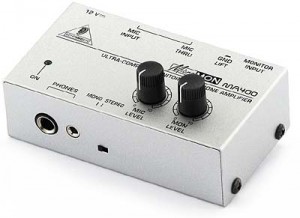Monitoring Vocals in the Recording Studio
One of the challenges that any engineer faces when recording vocals in the studio is creating a good mix in the headphones for the singer. The goal is to create a nice balance between the singer’s voice (which is being monitored directly from the microphone) and the rest of the recorded mix (the drums, guitars, bass, keys, other vocal tracks, etc.). If the singer can’t hear enough of their own voice in the headphones, they will have a tendency to go off pitch or sing too loudly into the mic. On the other hand, if they hear too much of their voice in the headphones (and not enough of the mix), they will often not be locked in well with the music and sing too softly, therby creating a weak performance.
So the challenge is to get just the right balance of the voice and the rest of the mix in the headphones to provide for a great recorded vocal track. I’ve tried using a couple of different monitoring methods, including using the software mixer that’s available with my recording interface, and monitoring through a hardware mixer by using an Aux send to create the monitor mix. But the problem always came down to control–I was in control of the mix, but I wasn’t the one doing the singing. So I would spend a considerable amount of time turning knobs and going back and forth with the singer until we had a balance that they were comfortable with.
So I came up with what I think is a fairly simple but effective solution: give the singer the ability to create their own headphone mix, putting them in control of the balance between the mic and music. The way to do this is with a simple headphone amp that comes equipped with a Mic Input and Mic Thru jack and an Auxiliary Input for the mix. These affordable devices are made by several manufacturers, including the Behringer MA400, Rolls Personal Monitor Amp, and Rolls Personal Monitor Station, (which offers an additional input for an instrument).
What these nifty little boxes allow you to do is connect a microphone to the Mic Input, and then connect the Mic Thru to the input of your mic preamp or mixer as normal. Then, you can connect one of the outputs of your sound card, recording interface, or mixer to the Monitor input of the device. The singer puts on their headphones and has one knob that controls the level of the mic and another knob that controls the level of the music. Voila–a custom headphone mix that puts the control in the hands of the singer. Need more mic? No problem–just turn up the “Mic” knob. Need less? Turn it down. Likewise with the mix.
I’ve been using this technique for over a year now, and it’s worked out great. We no longer have to waste valuable time in the studio trying to create the perfect headphone mix. Instead, the singer can create their own mix, and even make adjustments as needed–even after we’ve started recording. I will mention that there’s a danger to doing it this way: if the singer turns the mic up too loud in the headphones, they will instinctively sing too softly, which again creates a weak performance. So I generally advise the singer to first set the music/mix to a level that’s comfortable, and then turn up the mic until they can just hear their voice clearly with the mix. Then they can make minor adjustments as necessary.
Shop for these items at Zzounds:
 June 5, 2012
|
Posted by Jon (admin)
June 5, 2012
|
Posted by Jon (admin)


 Categories:
Categories:  Tags:
Tags: 